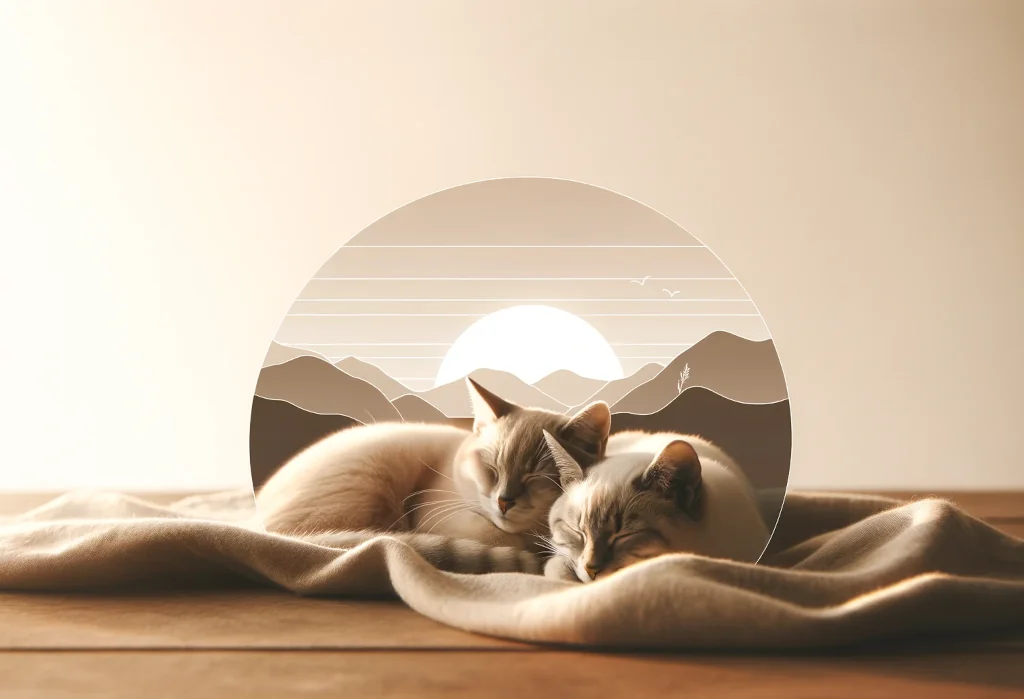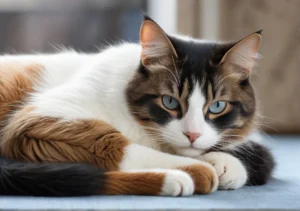Watching cats cuddle together can melt even the coldest of hearts, transforming a dull moment into a scene worth capturing. It’s like they’ve tapped into the secret of living in the moment, something we humans often strive for but seldom achieve. In this post, you’ll discover why our feline friends find comfort and joy in each other’s company, making us wish we could join their cozy cuddle puddles.
By the end of this read, you’ll have a better understanding of the sweet science behind cat cuddles, ensuring you never again underestimate the power of a good snuggle session between whiskered pals.

Quick Takeaways:
- Warmth, safety, social bonding, and mutual grooming are key reasons cats cuddle, showing affection and comfort.
- Facilitate a positive cuddling environment by slowly introducing cats, creating a safe space, and engaging in shared activities.
- Respect individual preferences; not all cats are cuddlers, but they can show affection in other unique ways.
Why Do Cats Cuddle Together?
Cats cuddling together is one of those heartwarming sights that might make you go, “Aww!” But have you ever wondered why they do this? Beyond the obvious cuteness factor, there are several pragmatic and emotional reasons behind this behavior.
First off, warmth plays a big role. Cats are fond of cozy spots and what’s warmer than snuggling up with a buddy? This behavior roots back to their kittenhood when they pile up with their siblings for warmth.
Safety is another key factor. In the wild, sticking together means better protection against predators. Even in the safety of a home, this instinct persists. Cuddling can also be a sign of social bonding. Cats who grow up together or are introduced properly tend to form strong social bonds, and cuddling is a way of reinforcing that connection.
Lastly, mutual grooming, or allogrooming, is a significant aspect of their cuddling behavior. It’s not only about keeping each other clean; it’s also a way to show affection and establish social hierarchies.
What Can You Do to Encourage Your Cats to Cuddle?
Creating an environment that promotes harmony among your cats can encourage them to cuddle more. Here are some tips:
- Introduce Cats Properly: A rushed introduction can lead to tension. Take it slow, allowing them to get used to each other’s scent before face-to-face meetings.
- Safe and Comfortable Environment: Ensure there are plenty of hiding spots and high perches. Cats feel more secure when they have their own space to retreat to.
- Shared Activities: Engage them in play at the same time. This helps build positive associations with each other’s presence.
A unique tip that’s often overlooked is using a calming pheromone diffuser. These mimic the pheromones mother cats release to calm their kittens and can create a more relaxing atmosphere for your cats to bond.
Does Cuddling Mean My Cats Really Love Each Other?
Cuddling is a strong sign of affection among cats, but it’s not the only one. When cats choose to cuddle, it often means they’re comfortable and feel safe with each other, indicating a strong bond.
However, it’s essential to observe other interactions between your cats. Do they groom each other? Do they play together without aggression? These are additional signs of genuine affection.
It’s worth noting that not all cats are cuddlers. Some may have a strong bond but show it in less obvious ways, such as simply choosing to hang out in the same room or showing a keen interest in the other’s well-being without physical contact.
Cuddling among cats is a multifaceted behavior influenced by their personalities, past experiences, and the environment they live in. By fostering a positive environment and respecting each cat’s individuality, you’re laying the groundwork for a strong, loving relationship, whether or not cuddling is part of their equation.
Are There Cats That Prefer Not to Cuddle?
Absolutely! Just like humans, cats come with their own personalities, preferences, and past experiences that shape how they interact with the world around them. It’s not uncommon to find a cat who prefers their space over a cozy lap. Several factors could influence this behavior:
- Personality Differences: Some cats are naturally more independent and don’t seek out physical affection as much as their more cuddly counterparts.
- Past Traumas: Cats who have had negative experiences with humans or other animals may be less inclined to cuddle. They may need more time to build trust.
- Personal Preference: Just as some people aren’t big on hugs, some cats simply prefer other forms of affection or interaction. It’s all about respecting their individual space and finding what works best for both of you.
Remember, not wanting to cuddle doesn’t mean a cat is unfriendly or doesn’t adore its human. They might show love in different ways, such as bringing toys, staying close by, or chatting with their characteristic meows and purrs. Observing and appreciating these unique expressions of affection is key to building a strong and respectful relationship with your feline friend.
Can Too Much Cuddling Be Harmful?
As much as we love a good cat cuddle, it’s possible to have too much of a good thing. Excessive cuddling can lead to a few issues to be mindful of:
- Dependency Issues: Cats who get used to constant cuddling might become overly dependent, experiencing separation anxiety when their human companions aren’t around.
- Overheating: Especially true for long-haired breeds, too much cuddling can make a cat uncomfortably warm, leading them to seek space.
- Neglecting Human Interaction: Cats who form a very tight bond with one another might become less interested in interacting with humans, which could be a drawback for pet owners seeking a close relationship with their pets.
To maintain a healthy balance, consider the following tips:
- Scheduled Playtime: Ensure you’re engaging in regular play sessions to keep your cat active and stimulated beyond cuddling time.
- Space Is Key: Provide ample space for your cat to retreat when they’ve had enough cuddling. A cozy bed in a quiet corner can be a perfect sanctuary.
- Alternate Affection: Show love through grooming, interactive toys, or treat-training sessions to bond with your cat in ways that don’t involve constant physical contact.
A Unique Piece of Advice
One often overlooked aspect of feline behavior is their response to the changing seasons. During colder months, you might notice your cats cuddling more frequently, not just for affection but for shared warmth.
Conversely, as temperatures rise, your cuddle buddies might start seeking solitude. This is a natural behavior and adapting to these seasonal changes by modifying your cuddling habits can greatly enhance the comfort and happiness of your furry friends. For example, transition to lighter, less intrusive ways of showing affection as the weather warms up, like gentle petting or providing a sunny window perch for basking.
By understanding and respecting our cats’ preferences and needs, we can ensure a happy, healthy, and balanced relationship with our beloved pets. Always keep an eye out for cues from your cat and remember that flexibility and patience are key to a harmonious coexistence.
Alex, a passionate animal lover, has experience in training and understanding animal behavior. As a proud pet parent to two dogs and three cats, he founded AnimalReport.net to share insights from animal experts and expand his knowledge of the animal kingdom.




